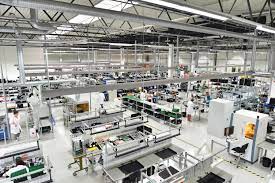Nigeria’s capacity utilisation drops by 0.4% in H1 2019

The Manufacturers Association of Nigeria (MAN) says that the sector’s capacity utilisation slowed to 54.1 per cent in the first half of 2019, compared to 54.50 per cent recorded in the first half of 2018, indicating 0.4 percentage point decline during the period under review.
The Director-General (MAN), Segun Ajayi-Kadir, revealed this in the association latest report, themed, “Executive summary of 2019 manufacturing outlook.”
He disclosed that “It also declined by 6.9 percentage point when compared with 61.0 per cent recorded in the second half of 2018. The fall in capacity utilisation of the sector in the period is as a result of poor macroeconomic, regulatory and infrastructure conditions in the economy.”
He noted that there was a decline in capacity utilisation in Food, Beverage and Tobacco group at 55.3 per cent, Wood & Wood Products at 49.4 per cent, Chemical & Pharmaceutical at 47.4 per cent and non-metallic at 52.7 per cent, among others.”Capacity utilisation declined in Food, Beverage and Tobacco group (55.3 per cent), Wood & Wood Products (49.4 per cent), Chemical & Pharmaceutical (47.4 per cent), Non-metallic (52.7 per cent) and Domestic/Industrial Plastic and Rubber group (52.2 per cent). However, it increased in the Textile Apparel & Footwear group (56.5 per cent), Pulp, Paper, Printing & Publishing (67.0 per cent), Electrical Electronics (48.2 per cent) and Motor Vehicle & Miscellaneous Assembly group (56.3 per cent).
“In the second half of 2019, Capacity utilization in Textile Apparel & Footwear group increased by 6.13 percentage point when compared with 50.17 per cent recorded in the corresponding half of 2018. However, the group declined by 3.4 percentage point when compared with 59.9 per cent recorded in the preceding half.”
The report revealed that industrial zones analyses presented a mixed-bag of performance, adding that while capacity utilisation in most of the zones increased in the first half of last year against the performance of the corresponding half of 2018, others declined when compared with the second half of 2018.
“Capacity utilisation in most of the zones increased in the first half of 2019 against the performance of the corresponding half of 2018 but declined when compared with the second half of 2018. Consequently, in the period under review, capacity utilization in Ikeja zone increased to 68.14 per cent; Ogun (69.19 per cent), Apapa (69.46 per cent), Kano Sharada/Challawa (55.11 per cent), Kaduna (49.5 per cent), Anambra/Enugu (43.8 per cent) and Rivers (54.07 per cent). Conversely, capacity utilization in Imo/Abia zone declined to 34.72 per cent, Kwara/Kogi (44.13 per cent) and Abuja (39.13 per cent) in the first half of 2019.
“In the first half of 2019 capacity utilisation in Ikeja zone increased by 12.96 and 0.54 percentage points when compared with 55.18 per cent and 67.6 per cent achieved in the first and second halves of 2018 respectively. Conversely, capacity utilization in Kwara/Kogi zone declined to 44.13 per cent in the first half of 2019 as against 49.67 per cent and 53.5 per cent recorded in the first and second halves of 2018 apiece.”
The report observed that manufacturing production in the first half of 2019 was affected by the same challenges that hindered capacity utilization in the period such as poor macroeconomic ambience, infrastructure issues and poor regulation by Government agencies.
“Utilisation of local raw materials in the Textile, Wearing Apparel, Carpet, Leather & Leather Footwear sector stood at 54.6 per cent in the first half of 2019, representing 8.09 and 3.0 percentage point the decline from 62.69 per cent and 57.6 per cent recorded in the same half of 2018 and the preceding half.”

He further explained that at the end of the first half of 2019, an estimated 1,644,392 historical cumulative jobs were created in the manufacturing sector based on the information gathered from the various surveys conducted by MAN over time.
“New manufacturing jobs in the first half of 2019 increased by 2674 and 3111 jobs from 9320 and 8883 jobs created in the first and second halves of 2018 respectively.
“In the first half of 2019, Chemical & Pharmaceutical sectoral group accounted for most of the jobs created in the manufacturing sector with 2784 employments; Domestic/Industrial Plastic & Rubber trailed with 2331 jobs; Motor Vehicle & Miscellaneous assembly with 2121 jobs; and Food, Beverage and Tobacco with job worth 1449 in the period.
He added that total job loss declined by 2753 from 6050 recorded in the first half of 2018 but increased by 710 jobs when compared with 2587 job losses in the second half of 2018.









